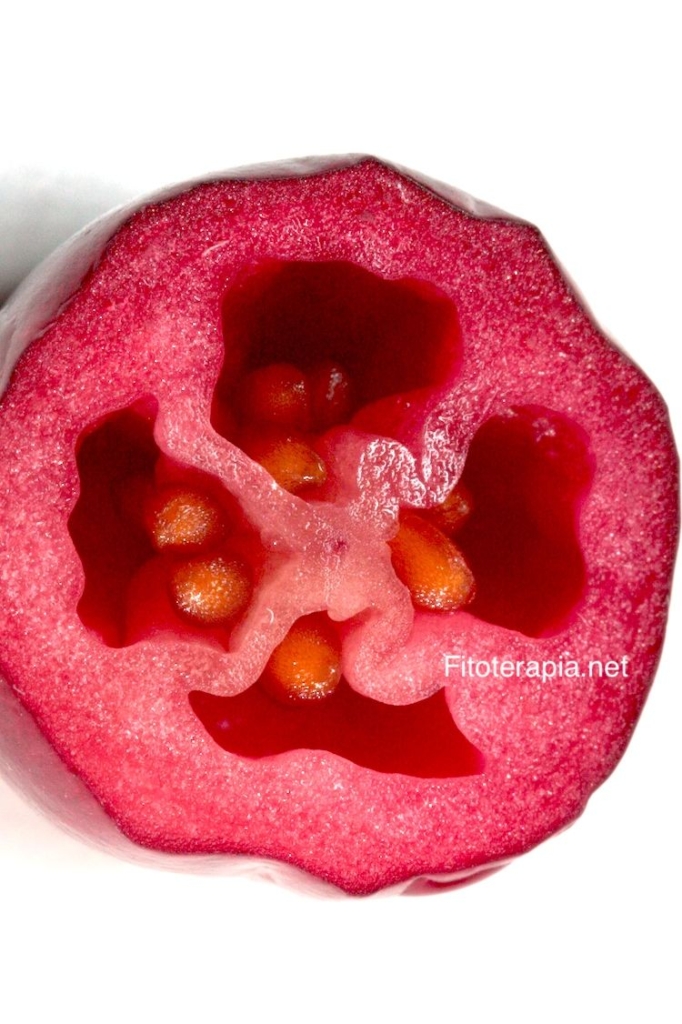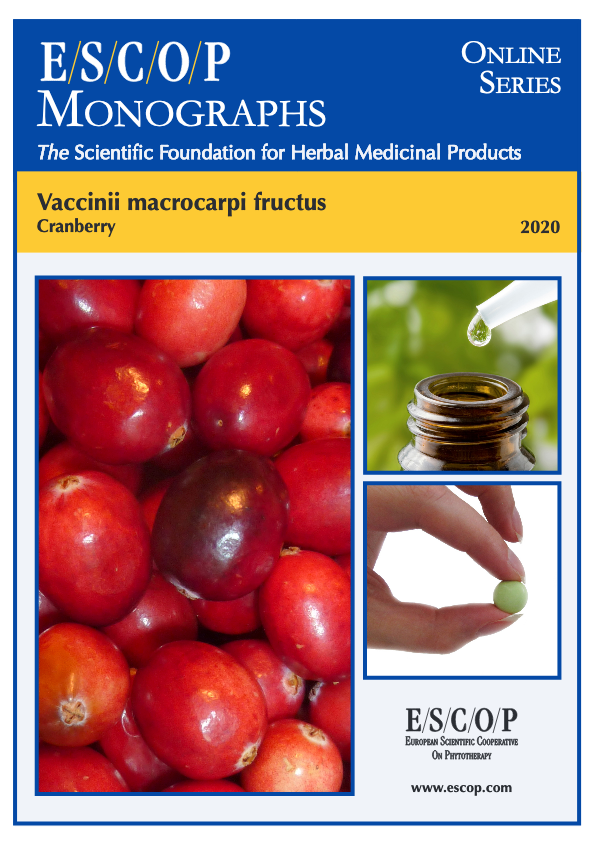
Background
The cranberry (Vaccinium macrocarpon Aiton, Ericaceae) is native to North America. It was highly valued by native Americans and later by colonists for its medicinal and nutritional benefits. The current use of fruits of cranberry is predominantly for the prevention of urinary tract infections (UTIs). Cranberries contain various proanthocyanidins (PACs), which have been shown to inhibit the adherence of p‐fimbriated Escherichia coli to the urothelial cells lining the bladder. However, there has been a great variability in the standards of clinical trials and variable outcomes reported, which has made it difficult to evaluate its effectiveness within a clinical setting. A recent Cochrane Systematic review (the fifth update of a review first published in 1998 and subsequently updated in 2003, 2004, 2008 and 2012) has provided some interesting conclusions that support the use of cranberry and cranberry supplements for the prevention of urinary tract infections in certain individuals.
Objective
To assess the effectiveness of cranberry products in preventing UTIs in susceptible populations.
Selection criteria
All randomised controlled trials (RCTs) or quasi‐RCTs of cranberry products compared with placebo, no specific treatment or other intervention (antibiotics, probiotics) for the prevention of UTIs were included.
Data collection and analysis
At least two authors independently assessed and extracted data. Information was collected on methods, participants, interventions and outcomes (incidence of symptomatic UTIs, positive culture results, side effects, adherence to therapy). Risk ratios (RR) with 95% confidence intervals (CI) were calculated where appropriate. Study quality was assessed using the Cochrane risk of bias assessment tool. Confidence in the evidence was assessed using the Grading of Recommendations Assessment, Development and Evaluation (GRADE) approach.
Main results
For this update, 26 new studies were added, bringing the total number of included studies to 50 (8857 randomised participants). The risk of bias for sequence generation and allocation concealment was low for 29 and 28 studies, respectively. Thirty‐six studies were at low risk of performance bias, and 23 studies were at low risk of detection bias. Twenty‐seven, 41, and 17 studies were at low risk of attrition bias, reporting bias and other bias, respectively.
Forty‐five studies compared cranberry products with placebo, water or no specific treatment in six different groups of participants. Twenty‐six of these 45 studies could be meta‐analysed for the outcome of symptomatic, culture‐verified UTIs. In moderate certainty evidence, cranberry products reduced the risk of UTIs (6211 participants: RR 0.70, 95% CI 0.58 to 0.84; I2 = 69%). When studies were divided into groups according to the treatment indication, cranberry products probably reduced the risk of symptomatic, culture‐verified UTIs in women with recurrent UTIs (8 studies, 1555 participants: RR 0.74, 95% CI 0.55 to 0.99; I2 = 54%), in children (5 studies, 504 participants: RR 0.46, 95% CI 0.32 to 0.68; I2 = 21%) and in people with a susceptibility to UTIs due to an intervention (6 studies, 1434 participants: RR 0.47, 95% CI 0.37 to 0.61; I2 = 0%). However, there may be little or no benefit in elderly institutionalised men and women (3 studies, 1489 participants: RR 0.93, 95% CI 0.67 to 1.30; I2 = 9%; moderate certainty evidence), pregnant women (3 studies, 765 participants: RR 1.06, 95% CI 0.75 to 1.50; I² = 3%; moderate certainty evidence), or adults with neuromuscular bladder dysfunction with incomplete bladder emptying (3 studies, 464 participants: RR 0.97, 95% CI 0.78 to 1.19; I2 = 0%; low certainty evidence).
Other comparisons were cranberry products with probiotics (three studies) or antibiotics (six studies), cranberry tablets with cranberry liquid (one study), and different doses of PACs (two studies).
Compared to antibiotics, cranberry products may make little or no difference to the risk of symptomatic, culture‐verified UTIs (2 studies, 385 participants: RR 1.03, 95% CI 0.80 to 1.33; I2 = 0%) or the risk of clinical symptoms without culture (2 studies, 336 participants: RR 1.30, 95% CI 0.79 to 2.14; I2 = 68%). Compared to probiotics, cranberry products may reduce the risk of symptomatic, culture‐verified UTIs (3 studies, 215 participants: RR 0.39, 95% CI 0.27 to 0.56; I = 0%). It is unclear whether efficacy differs between cranberry juice and tablets or between different doses of PACs, as the certainty of the evidence was very low.
The number of participants with gastrointestinal side effects probably does not differ between those taking cranberry products and those receiving a placebo or no specific treatment (10 studies, 2166 participants: RR 1.33, 95% CI 1.00 to 1.77; I2 = 0%; moderate certainty evidence). There was no clear relationship between compliance with therapy and the risk for repeat UTIs. No difference in the risk for UTIs could be demonstrated between low, moderate and high doses of PACs.
Conclusion
This update adds a further 26 studies, taking the total number of studies to 50 with 8857 participants. These data support the use of cranberry products to reduce the risk of symptomatic, culture‐verified UTIs in women with recurrent UTIs, in children, and in people susceptible to UTIs following interventions. The evidence currently available does not support its use in the elderly, patients with bladder emptying problems, or pregnant women.
Implications for practice
The current body of evidence suggests that cranberry products (either in juice or as tablets or powder) compared to placebo or no treatment probably reduce the risk of symptomatic UTIs in women with recurrent UTIs, in children, and in people at risk of UTIs following an intervention.
The data did not support the use of cranberry products to reduce the risk of symptomatic UTIs in elderly men and women, in pregnant women or in adults with neuromuscular dysfunction of the bladder and incomplete bladder emptying. However, data in these latter groups are limited to small studies with considerable uncertainty around the results.
Implications for research
There remains considerable uncertainty about the appropriate dose of PAC intake via cranberry product required to reduce the risk of UTIs so further studies using different doses of PAC intake are required to determine the dose with the highest efficacy and tolerability and the lowest risk of adverse effects in the patient groups at risk of symptomatic UTIs.
The amount of PAC within cranberry products needs to be standardised between products, with products clearly labelled to include PAC content.
More studies are required to assess the relative efficacy and safety of cranberry products compared with antibiotics or probiotics to prevent symptomatic UTIs.
Dr. Christopher J. Etheridge. British Herbal Medicine Association (BHMA) Chair
Reference: Williams G, Stothart CI, Hahn D, Stephens JH, Craig JC, Hodson EM. Cranberries for preventing urinary tract infections. Cochrane Database of Systematic Reviews 2023, Issue 11. Art. No.: CD001321. DOI: 10.1002/14651858.CD001321.pub7. Accessed 17 May 2025.
📍📍📍 More information about Cranberry:
European Scientific Cooperative on Phytotherapy. ESCOP monographs The Scientific Foundation for Herbal Medicinal Products. Online series. Vaccinii macrocarpi fructus (Cranberry). Exeter: ESCOP; 2020. 50 pages.
- Download monograph
- Online viewing monograph
